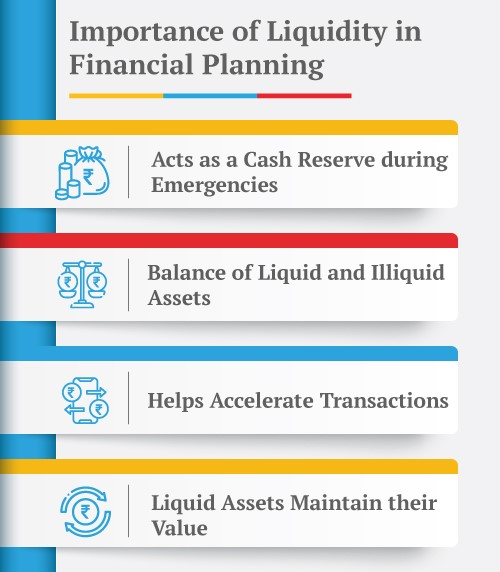You must have come across the term “Liquidity” in personal finance. So, what is liquidity? And why is liquidity so important in financial planning? In simple terms, if you can give away your asset and get cash in return, that is liquidity. If such an exchange is very difficult, your asset is illiquid, whereas if it is super easy, your asset is highly liquid. Therefore, the degree of ease in exchanging assets for cash determines the degree of liquidity.
Importance of Liquidity in Financial Planning | Financial Planning Tips
If your assets can be exchanged for cash without losing their value, your investments are “liquid”. In most cases all assets are liquid, but what differentiates one asset from another is the degree of liquidity.
“Some investments are more easily turned to cash whereas others will need time and effort.”
Personal financial planning requires you to park some funds in asset classes that are highly liquid so that you have money in hand for emergencies. These financial instruments may not necessarily give better than average returns. At the other end of the spectrum, you must also invest in assets that could be illiquid but gives market-beating returns in the long run.
Investment liquidity has the following characteristics:
a) Higher liquidity often means a lower rate of return; i.e., savings accounts, liquid funds
b) Higher liquidity with the possibility of higher returns indicates very high investment risk; i.e., equity stocks, derivative contracts
c) Large physical assets have low liquidity
d) Investments with lower liquidity can offer higher investment growth
Also Read - How to Invest Money?
Examples Liquidity vs Investment Return
Highly liquid instruments allow you to withdraw money anytime and anywhere. No restrictions whatsoever. Two examples of how liquidity and investment returns correlate are:
a) Savings Bank Account
Although the interest rates are nominal and may not even beat inflation, you can withdraw money from any ATM, transfer funds to your family members or make monthly bill payments.
b) Bank Fixed Deposits
Bank fixed deposits (FDs) give better returns as compared to savings accounts. FDs are also highly liquid but require you to place an online/offline request for premature withdrawal. However, if you exercise the liquidity option you lose the return on investment. You will receive a lower ROI due to the penalty applied to early withdrawals.
Thus, even though the process is fairly straightforward and simple and the amount is deposited in your account within a few hours or a day. Higher liquidity can affect your return on investment.
This is also why FDs are good to park funds for emergency expenses and unforeseen exigencies. Since you don’t know when you will need to withdraw, your money will enjoy higher growth if you don’t, but will always be available to you on short notice.
Liquid Vs Illiquid Investments
Liquid and illiquid investments are at the two opposite ends of the spectrum. Liquid investments are super easy to convert into cash (at short notice) whereas illiquid investments are super difficult to convert into cash (at short notice). The objectives and investment timelines for both types are completely different.
“If you try to convert illiquid assets into cash at short notice, you may have to trade off its value.”
For example, let’s say you own a property in a suburb and have hypothecated the same to a bank. During an organization restructuring, your income is under severe stress and you find it extremely difficult to pay your EMIs. You want to sell off your property and clear the bank loan. Finding a buyer quickly could be difficult. Even if you manage to find one, you will end up selling the property at below-market value to get the money.
So, the transaction ends in a distressed sale. To avoid such scenarios, it is best to set aside some money in liquid funds such as bank savings accounts and fixed deposits. The return on investment will not be as high as in real estate, but you will have money when you need it the most.
Investing in real estate, long-term bonds, and gold should be done with a long-term horizon in mind. One, these assets take time to generate the kind of returns expected from them. Two, selling too quickly is difficult and costly.
Role of Liquidity in Financial Planning
Liquidity has a very important role in financial planning so that you can strike a balance between your short-term, medium-term and long-term goals. Some reasons why liquidity is important in financial planning:
1. Highest Liquidity
Cash reserves or emergency funds - keep six months equivalent of your income in fixed deposits. This is just a thumb rule and the exact amount can vary for different people depending on individual circumstances. This reserve should be touched only in case of exigencies and emergencies. For routine expenses, you can keep an appropriate amount in your savings account.
2. Medium Liquidity + Stable Returns
Your mid-term goals which are more than a year away but fall within the next five years need investments with lower liquidity. This means that you can invest your money for higher growth. For example, corporate debt funds, etc. Which will offer higher growth in this period, but only if you stay invested.
3. Lowest Liquidity + Highest Growth
Long-term financial goals can use long-term investments. These investments like NPS, ULIPs, and PPF, may offer lower liquidity but can offer higher growth with time. These investments are perfect if you want to invest in goals like a child’s education, retirement, home purchase, etc.
How does Financial Planning Maintain Liquidity?
When you have a proper financial plan in place, you will know how much money you would require at every important stage in life. Financial planning helps you plan your current and future cash flows such that you have enough every time you need it.
You will never run short of cash when you need it when you have planned and invested. Some typical scenarios:
1. Car Purchase/Replacement:
Your car is 7 years old. You will have to replace it in another 8 years. You can use the following investment options to meet this goal:
a. Public Provident Fund (PPF):
You can make partial withdrawals after 6 years. You can use that amount to make the down payment or full payment towards your new car.
b. Unit Linked Insurance Plans (ULIPs):
ULIPs also allow partial withdrawals after 5 years. Also, you can invest in both equity and debt funds. You can also choose to withdraw from one fund.
c. Mutual Funds:
You can invest in equity and debt mutual funds as per your risk appetite.
Keeping money in ULIP, PPF or MFs will fetch better returns for the available time than letting it be in the savings account.
2. Child’s Education:
You may need money to pay your child’s University fees when they finishes high school. If s/he is currently 3 years old and may join University at 18, you can plan your investments for 15 years:
a. PPF:
Maturity period is 15 years + partial withdrawals available after 6
b. ULIPs:
15 years is a good growth period. With plans like Invest 4G from Canara HSBC Life Insurance, you can enjoy bonus additions as well
3. Your Retirement:
Ideally you should start saving for retirement the moment you start earning. But even if you are 45 you can start with additional investment:
a. National Pension Scheme (NPS):
Normal withdrawals are allowed only after you are 60 years of age. Exposure to equity funds, and automatically managed allocation.
b. ULIPs:
Invest in a plan up to the age of 99 with Invest 4G ULIP. Build a strong corpus until you need to start your pension. Then enjoy a tax-free pension with a partial withdrawal facility.
You must invest up to 15% of your annual income until 60. Don’t bank on that fund for the next 15 years.
Be in control of your money. Invest in assets and financial instruments after thoroughly planning your financial requirements for the short-term, medium-term and long-term. Keep aside a kitty to help you tide over emergencies and temporary setbacks. Have a robust plan so that you don’t run short of money despite having assets.
Disclaimer: This article is issued in the general public interest and meant for general information purposes only. Readers are advised to exercise their caution and not to rely on the contents of the article as conclusive in nature. Readers should research further or consult an expert in this regard.
Financial Planning - Top Selling Plans
We bring you a collection of popular Canara HSBC life insurance plans. Forget the dusty brochures and endless offline visits! Dive into the features of our top-selling online insurance plans and buy the one that meets your goals and requirements. You and your wallet will be thankful in the future as we brighten up your financial future with these plans.
Fixed Returns, Zero Risks & Worries
- 4 Plan options
- Life cover + Guaranteed benefits
- Accidental death benefit
- Premium protection cover
Save, Dream, Plan. Live Peacefully
- 5 Plan options
- Option to choose PPT
- Get Tax benefits
- Premium protection cover
Recent Blogs






